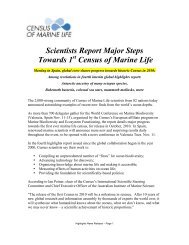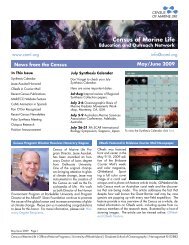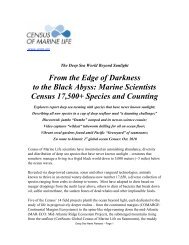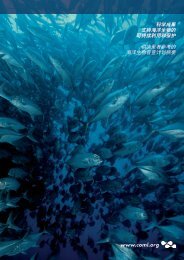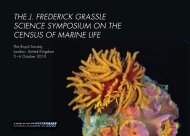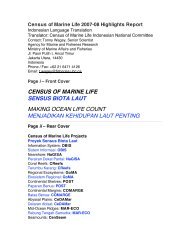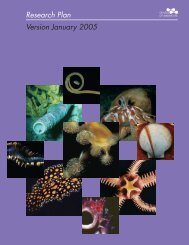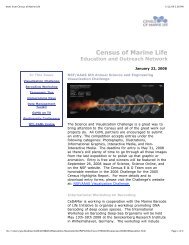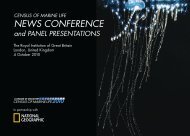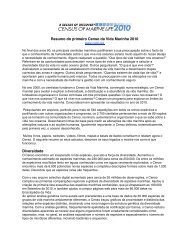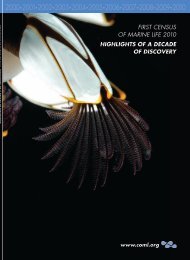Census of Marine Life Iconic Images Captions and Credits
Census of Marine Life Iconic Images Captions and Credits
Census of Marine Life Iconic Images Captions and Credits
You also want an ePaper? Increase the reach of your titles
YUMPU automatically turns print PDFs into web optimized ePapers that Google loves.
<strong>Census</strong> <strong>of</strong> <strong>Marine</strong> <strong>Life</strong> <strong>Iconic</strong> <strong>Images</strong><br />
High-resolution versions <strong>of</strong> the images in this screensaver are available<br />
from the <strong>Census</strong> <strong>of</strong> <strong>Marine</strong> <strong>Life</strong> Education <strong>and</strong> Outreach <strong>of</strong>fice. If you wish<br />
to request high-resolution images for use in <strong>Census</strong> <strong>of</strong> <strong>Marine</strong> <strong>Life</strong>-related<br />
photo exhibits, please contact Frank Baker at fbaker@gso.uri.edu or Sara<br />
Hickox at sara@gso.uri.edu.<br />
Anemone hermit crab- from the family paguridae (one <strong>of</strong><br />
two collected from this family on this expedition),<br />
collected from cold deep water in a baited trap, appears<br />
to have its own species <strong>of</strong> anemone attached to the shell;<br />
that is, it seems that this species <strong>of</strong> hermit crab has a<br />
specific species <strong>of</strong> anemone associated with it, which<br />
does not attach to other species <strong>of</strong> hermit crabs. The<br />
shiny gold color on the claws is a phenomenon not seen before by expedition<br />
scientists; they will research whether this "shiny communication" is known or novel in<br />
the scientific community. This spectacular crab <strong>and</strong> its anemone captured the interest <strong>of</strong><br />
everyone on the cruise, raising more questions than it answers. Image Courtesy <strong>of</strong><br />
Susan Middleton © 2007<br />
The acantharians are one <strong>of</strong> the four types <strong>of</strong> large amoebae<br />
that occur in marine open waters. Their fragile skeletons are<br />
made <strong>of</strong> a single crystal <strong>of</strong> strontium sulfate that quickly<br />
dissolves in the ocean water after the cell dies. Image<br />
Courtesy <strong>of</strong> Linda Amaral Zettler, micro*scope<br />
Bluefin Tuna. Image Courtesy <strong>of</strong> Richard Hermann-<br />
Galatée Films
Near a vent 3km beneath the equatorial Atlantic,<br />
<strong>Census</strong> researchers, using equipment attached to the<br />
remotely operated vehicle Quest, found shrimp <strong>and</strong><br />
other life forms. Image Courtesy <strong>of</strong> MARUM, Bremen<br />
University<br />
A new species <strong>of</strong> Lysianassoid, an amphipod<br />
crustacean sampled near Elephant Isl<strong>and</strong>, Antarctic<br />
Peninsula, during the Polarstern cruise ANTXXIII-8.<br />
Image Courtesy <strong>of</strong> Cédric d’Udekem d’Acoz<br />
Sea nettles, Monterey Bay California, USA. Image<br />
Courtesy <strong>of</strong> Richard Hermann- Galatée Films<br />
Marrus sp., a physonect siphonophore. Image<br />
Courtesy <strong>of</strong> Kevin Rask<strong>of</strong>f<br />
Great White Shark: When it is calm <strong>and</strong> confident, the<br />
shark's pectoral fins are horizontal. However, it lowers<br />
its fins when it makes an intimidating charge. Image<br />
Courtesy <strong>of</strong> Pascal Kobeh – Galatée Films
Cirrate octopod, found at around 800m in the Gulf <strong>of</strong><br />
Maine. Stauroteuthis syrtensis is one <strong>of</strong> the few<br />
bioluminescent octopuses. Photophores in its mouth are<br />
believed to fool prey by directing them towards the<br />
mouth. It is relatively common <strong>of</strong>f the continental slope<br />
<strong>of</strong> the eastern USA, although it occurs across the North<br />
Atlantic. This specimen was photographed during a<br />
2004-2005 expedition to the Mid-Atlantic Ridge. Image Courtesy <strong>of</strong> David Shale<br />
Keelung.<br />
A new species, this blind lobster with bizarre chelipeds<br />
belongs to the rare genus Thaumastochelopsis, which<br />
was previously known only from four specimens <strong>of</strong> two<br />
species in Australia. The specimen collected during the<br />
MNHN/USNM/BFAR AURORA 2007 expedition from<br />
about 300m is a new species. Image Courtesy <strong>of</strong> Tin-<br />
Yam Chan, National Taiwan Ocean University,<br />
Nereocystis, a marine alga commonly referred to as<br />
bull kelp, is <strong>of</strong>ten found in the nearshore <strong>and</strong> shallow<br />
gulf areas <strong>of</strong> the Pacific coast <strong>of</strong> North America.<br />
Image Courtesy <strong>of</strong> Brenda Konar<br />
The final diving lessons for this young Weddell<br />
seal. It is the size <strong>of</strong> his mother who is waiting<br />
under the water. He will very soon be<br />
independent. Image Courtesy <strong>of</strong> Galatée Films
A lovely pink siphonphore, Athorybia rosacea, from<br />
the Sargasso Sea is actually a colonial organism<br />
similar to the Portuguese Man O'War. Image<br />
Courtesy <strong>of</strong> Laurence Madin, WHOI<br />
S<strong>and</strong> fleas (amphipod crustaceans) under<br />
nearshore ice in the Beaufort Sea. Ice-associated<br />
amphipods are a major food source for Arctic<br />
cod, in turn the main prey for ice seals. Image<br />
Courtesy <strong>of</strong> Shawn Harper, University <strong>of</strong> Alaska<br />
Fairbanks.<br />
The goose barnacle Lepas anatifera, attached by a<br />
flexible stalk to any floating object such as drift wood,<br />
plastic pots or fishing boats, has a worldwide<br />
distribution. Image Courtesy <strong>of</strong> David Shale<br />
Clione limacina, an Arctic pelagic snail (pteropod). Image<br />
Courtesy <strong>of</strong> Kevin Rask<strong>of</strong>f
This bizarre new copepod, Ceratonotus steiningeri, was first<br />
discovered 5,400 meters deep in the Angola Basin in 2006.<br />
Within a year it was also collected in the southeastern<br />
Atlantic, as well as some 13,000 kilometers away in the<br />
central Pacific Ocean. Scientists are puzzled about how this<br />
tiny (0.5mm) animal achieved such widespread distribution<br />
as they are about how it avoided detection for so long.<br />
Image Courtesy <strong>of</strong> Jan Michels<br />
A Cranchiidean larval squid was collected from the South<br />
Atlantic Ocean <strong>of</strong>f the coast <strong>of</strong> Africa. Image Courtesy <strong>of</strong><br />
Cheryl Clarke Hopcr<strong>of</strong>t<br />
In October 2007, U. S. <strong>and</strong> Filipino scientists traveled<br />
to the Celebes Sea in Southeast Asia, searching for<br />
new species living in its deep water. When they<br />
discovered this extraordinary worm—which they named<br />
“Squidworm”—they knew they had something<br />
completely different. WHOI scientist Larry Madin <strong>and</strong><br />
National Geographic Society photographer Emory<br />
Krist<strong>of</strong> led the expedition, which was supported by the NOAA Office <strong>of</strong> Exploration,<br />
the National Geographic Society, <strong>and</strong> the WHOI Ocean <strong>Life</strong> Institute (OLI). Image<br />
Courtesy <strong>of</strong> Laurence Madin, WHOI<br />
Grey reef shark <strong>and</strong> blacktip shark hovering over<br />
pristine coral reef at Malden Isl<strong>and</strong>, Southern Line<br />
Isl<strong>and</strong>s, Kiribati. Image Courtesy <strong>of</strong> Enric Sala<br />
A golden lace nudibranch, Halgerda terramtuentis, was<br />
collected in the waters <strong>of</strong> the Northwestern Hawaiian<br />
Isl<strong>and</strong>s. Image Courtesy <strong>of</strong> Cory Pittman, NOAA, PIFSC,<br />
NHIMN
The leafy Seadragon, Phycodurus eques, is camouflaged<br />
to resemble a piece <strong>of</strong> drifting seaweed. Image Courtesy<br />
<strong>of</strong> Karen Gowlett-Holmes<br />
This large anemone is found from the Arctic to Cape<br />
Cod along the eastern United States coast. Nearshore<br />
they grow up to 15 centimeters in diameter, <strong>and</strong><br />
<strong>of</strong>fshore tend to be even larger. They are equipped<br />
with powerful stinging cells. Exp<strong>and</strong>able mouths open<br />
wide enough to allow them to feed on small fish,<br />
urchins, crabs, jellies, <strong>and</strong> other invertebrates that<br />
venture too close. Image Courtesy <strong>of</strong> Andrew J. Martinez<br />
A jellyfish (Chrysaora melanaster) moves through the<br />
water in the high Arctic Ocean's Canada Basin, an<br />
area that was surveyed as part <strong>of</strong> the <strong>Census</strong> <strong>of</strong><br />
<strong>Marine</strong> <strong>Life</strong>. Image Courtesy <strong>of</strong> Kevin Rask<strong>of</strong>f<br />
Mysid Gnathophausia sp. from a net trawl from<br />
2,600 meters. Image Courtesy <strong>of</strong> David Shale<br />
Brisingiid Starfish on seamount feeding in water<br />
current. Also corals <strong>and</strong> other invertebrate fauna.<br />
Image Courtesy <strong>of</strong> National Institute <strong>of</strong> Water <strong>and</strong><br />
Atmospheric Research (NIWA, New Zeal<strong>and</strong>)
The ghost-like sea-angel Platybrachium antarcticum, flies<br />
through the deep Antarctic waters hunting the shelled pteropods<br />
(another type <strong>of</strong> snail) on which it feeds. Image Courtesy <strong>of</strong><br />
Russ Hopcr<strong>of</strong>t, University <strong>of</strong> Alaska Fairbanks<br />
This pink see-through fantasia, Enypniastes, is a swimming<br />
sea cucumber seen about 2,500 meters deep in the Celebes<br />
Sea. In 2007 WHOI biologist Larry Madin led a team <strong>of</strong><br />
scientists <strong>and</strong> photographers from the U.S. <strong>and</strong> the<br />
Philippines on an expedition to explore biodiversity in the<br />
deep Celebes Sea, supported by the National Oceanic <strong>and</strong> Atmospheric<br />
Administration, the National Geographic Society, <strong>and</strong> the WHOI Ocean <strong>Life</strong> Institute.<br />
The team used scuba diving, nets, cameras, <strong>and</strong> ROVs to study the deep sea in this<br />
area that has been called a "cradle <strong>of</strong> biodiversity for shallow water marine animals."<br />
Image Courtesy <strong>of</strong> Laurence Madin<br />
The Arctic copepod, Euaugaptilus hyperboreus, uses the<br />
elongated setae on its mouth-parts to ensnare struggling prey.<br />
Image Courtesy <strong>of</strong> Russ Hopcr<strong>of</strong>t, University <strong>of</strong> Alaska<br />
Fairbanks<br />
A jelly fish <strong>of</strong> the genus Crossota, collected from the deep<br />
Arctic Canada Basin with an ROV. Image Courtesy <strong>of</strong><br />
Kevin Rask<strong>of</strong>f<br />
Sockeye salmon. Image Courtesy <strong>of</strong> Galatée Films
"New" Dumbo (Grimpoteuthis sp.), a cirrate octopod,<br />
photographed over the Mid-Atlantic Ridge. Image Courtesy<br />
<strong>of</strong> David Shale<br />
Seastar along the shore <strong>of</strong> Cobscook Bay, Maine, August<br />
2007. Image Courtesy <strong>of</strong> Christina Kulfan<br />
Collected from the DIVA 2 cruise in February/March 2005 at<br />
5000m depth in the Southern Atlantic Ocean, what appears to be<br />
an ancient gold treasure is a magnified crustacean, a tiny copepod.<br />
Image Courtesy <strong>of</strong> Marco Büntzow, Paulo Corgosinho<br />
This striking creature, a Venus flytrap anemone, Actinoscyphia sp.,<br />
was photographed in the Gulf <strong>of</strong> Mexico. Photo: Ian MacDonald,<br />
Florida State University.<br />
The tube anemone, or tube dwelling anemone, lives in a mucous<br />
tube on the muddy bottoms <strong>of</strong> coastal waters, estuaries, <strong>and</strong> s<strong>of</strong>t<br />
seabeds. These attractive anemones are found in tropical <strong>and</strong><br />
subtropical waters throughout the world, where they can grow up<br />
to 15cm (6 in) across <strong>and</strong> 30cm (12 in) tall. When the anemone<br />
is threatened, the animal retracts into its tube for protection. The beautiful stinging<br />
tentacles <strong>of</strong> the tube anemone vary from a vibrant purple to a creamy brown. Credit:<br />
Karen Gowlett-Holmes
Vampyroteuthis, or vampire squid, is a cephalopod that lives in the<br />
oxygen minimum zone <strong>of</strong> Monterey Bay, California, at depths <strong>of</strong><br />
600-900 meters. Credit: Kim Reisenbichler, MBARI<br />
Gary Cranitch's photographs for CReefs were<br />
recognized for excellence by the Australian Institute <strong>of</strong><br />
Pr<strong>of</strong>essional Photographers. This spectacular jellyfish<br />
inhabits the water <strong>of</strong> the Great Barrier Reef <strong>of</strong>f Lizard<br />
Isl<strong>and</strong>, Queensl<strong>and</strong>, Australia. Credit: Gary Cranitch,<br />
Queensl<strong>and</strong> Museum<br />
The Antarctic ice fish has no red blood pigments<br />
(hemoglobin) <strong>and</strong> no red blood cells. This is an<br />
adaptation to the low temperature. The blood becomes<br />
more fluid, as a consequence, the animal saves energy<br />
to pump blood through its body. Interestingly the brittle<br />
stars are overgrown by a yellow sponge. Credit: J. Gutt<br />
© AWI/Marum, Univ. <strong>of</strong> Bremen Germany<br />
In the abyssal Pacific Ocean at 5000m, a sea cucumber,<br />
Psychropotes longicauda, ingests sediments from around a<br />
field <strong>of</strong> manganese nodules. It is a widely distributed<br />
deposit feeder that uses its upright "sail" to use current<br />
energy for transport along the seafloor. Credit: Ifremer,<br />
Nordinaut cruise 2004<br />
This octopus specimen was collected at Lizard isl<strong>and</strong> in an ARMS<br />
(Autonomous Reef Monitoring System) at 14.39S, 145.27E at a<br />
depth <strong>of</strong> 10-12m. Credit: Dr. Julian Finn, Museum Victoria
Three subarctic sunflower stars, Pycnopodia helianthoides,<br />
crawl along the seafloor in shallow waters <strong>of</strong>f Knight Isl<strong>and</strong><br />
in Prince William Sound, Alaska, USA. Credit: Casey<br />
Debenham, University <strong>of</strong> Alaska Fairbanks<br />
South <strong>of</strong> Easter Isl<strong>and</strong>, <strong>Census</strong> vent explorers discovered a<br />
crab so unusual it warranted a whole new family<br />
designation, Kiwidae. Beyond adding a new family to the<br />
wealth <strong>of</strong> known biodiversity, its discovery added a new<br />
genus, Kiwa, named for the mythological Polynesian<br />
goddess <strong>of</strong> shellfish. Its furry or hairy appearance justified<br />
its species name, hirsuta. Photo: Ifremer, A.Fifis, 2006<br />
Exceeding two meters in length, the Napoleon Wrasse is one <strong>of</strong><br />
the largest reef fish found in the warm waters <strong>of</strong> the Indian <strong>and</strong><br />
Pacific oceans. The intricate blue-green design that decorates the<br />
face resembles New Zeal<strong>and</strong> Maori war paint, which is the root<br />
<strong>of</strong> its alternative name, the Maori Wrasse. The designs are also<br />
unique to each individual, much like fingerprints. A protogynous hermaphrodite, this<br />
wrasse can change its sex from female to male. Credit: Molly Timmers NOAA PIFSC<br />
Coral Reef Ecosystem Division<br />
A scanning electron microscope image <strong>of</strong> a Protoperidinium<br />
pellucidum, an armored din<strong>of</strong>lagellate, collected at Port Jackson in<br />
Sydney, Australia. Photo: Stephanie Valentin <strong>and</strong> D.J. Patterson,<br />
micro*scope.<br />
The jewelled squid, Histioteuthis bonnellii, swims above the Mid-<br />
Atlantic Ridge at depths from 500m to 2,000m. Credit: David Shale
This photograph taken near Cape Town shows both a newly<br />
discovered species <strong>of</strong> shrimp (Hippolyte catagrapha) <strong>and</strong> a<br />
new species <strong>of</strong> Myzostomid (the yellow object beneath the<br />
shrimp). Both are commensal on crinoids. Credit: Guido<br />
Zsilavecz-SURG<br />
American lobster, Homarus americanus, in shallow water<br />
<strong>of</strong>f eastern Canada in a protective habitat that also<br />
provides home for many other invertebrates. Credit: Mike<br />
Strong & Maria-Ines Buzeta<br />
In Alaska's Aleutian Isl<strong>and</strong>s, nearshore researchers have<br />
discovered new species even in shallow water, such as this<br />
kelp, Aureophycus aleuticus. Photo: Max K. Hoberg, Institute<br />
<strong>of</strong> <strong>Marine</strong> Science, University <strong>of</strong> Alaska Fairbanks.<br />
"Fisherman clothes" Detail <strong>of</strong> a print by Nicholas De Larmessin, XVII<br />
century.<br />
Flamingo tongue snail, Cyphoma gibbosum, was photographed<br />
near Gr<strong>and</strong> Cayman, British West Indies, <strong>and</strong> is listed in the Gulf<br />
<strong>of</strong> Mexico biodiversity inventory. Credit: Kacy Moody<br />
Antarctic male pycnogonid bearing its eggs, a marine distant<br />
relative <strong>of</strong> spiders, sampled in the Larsen A area, Antarctic<br />
Peninsula, during the Polarstern expedition ANTXXIII-8. Credit:<br />
Pablo J. Lopez-Gonzalez Universidad de Sevilla
Researcher Dr. Niel Bruce <strong>of</strong> the Museum <strong>of</strong> Tropical<br />
Queensl<strong>and</strong> studies specimens in lighted aquarium on<br />
Lizard Isl<strong>and</strong> Reef. Credit: Gary Cranitch-Queensl<strong>and</strong><br />
Museum<br />
<strong>Census</strong> researchers conducted an inventory <strong>of</strong> octocorals, named for<br />
the eight tentacles that fringe each polyp. Shown is a s<strong>of</strong>t coral,<br />
Dendronephthya, from coral gardens <strong>of</strong>f Lizard Isl<strong>and</strong>. Gary<br />
Cranitch, Queensl<strong>and</strong> Museum 2008<br />
Christmas tree worm found at Lizard Isl<strong>and</strong>. Credit: John<br />
Huisman-Murdoch Univ.<br />
A Fathead (Psychrolutes microporos) trawled during the<br />
NORFANZ expeditions at a depth between 1013m <strong>and</strong><br />
1340m, on the Norfolk Ridge, north-west <strong>of</strong> New<br />
Zeal<strong>and</strong>, June 2003. Photo © NORFANZ Founding<br />
Parties Photographer Kerryn Parkingson; additional<br />
thanks to Peter McMillan & Andrew Stewart<br />
TOPP scientists at work tagging a bluefin tuna. Credit: Tag-A-<br />
Giant<br />
Humpback whales feeding on herrings. Chatham Strait, Alaska, USA.<br />
Credit: François Sarano- Galatée Films
A scanning electron microscope image <strong>of</strong> a Peridinium collected<br />
at Port Jackson in Sydney, Australia. Photo: Stephanie Valentin<br />
<strong>and</strong> D.J. Patterson, micro*scope


